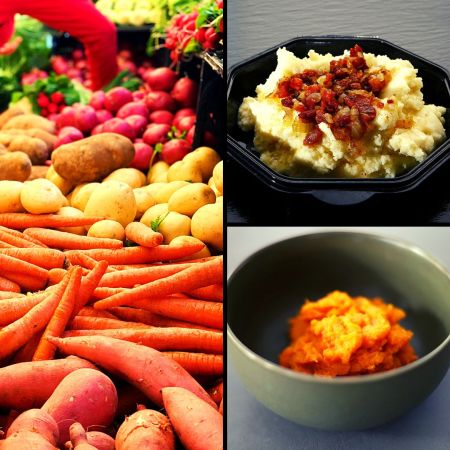How to Make Any Root Veggie into a Scrumptious Mash Everyone Will Love
Fall and holidays are classic times of year for serving mashed veggies.
Mashed potatoes and/or sweet potatoes anyone?
I know my family is always as eager to dig into those as they are the other fixings at holidays and family meals.
Because that's the point, right? Eat those veggies, too! (Not just the bread and/or meat.)
But, hang on, why stop at the well known mashes?
Mashed veggies can be made with many kinds of roots in endless spicing and flavor combinations to satisfy any occasion, mundane or fancy.
That's why I'm here today with this fun formula for making your perfect mashed veggie combos.
To help inspire you to try a few new things and liven up your winter tables with delicious healthy root veggies!
To ultimately eat more veggies in interesting ways!

The steps to making any root veggie into a scrumptious mash everyone will love
It's not at all hard to make a mash. We've all done it before. So this formula will give you fun ideas to broaden your options when your fridge is full of fresh veggies and you've got a meal to make.
Step one: Pick your veggies
So, what exactly can you mash?
Going beyond mashed potatoes or sweet potatoes isn't as hard as you might think. Here is a list of all the root (+ beyond) veggies you can mash with good success:
- Potatoes
- Sweet Potatoes
- Parsnips
- Celeriac (aka Celery Root)
- Rutabaga
- Turnips
- Carrots
- Kohlrabi
- Cauliflower
- Winter Squash
- Pumpkin
Other veggie add-in options:
- Kale
- Cabbage
- Garlic
- Onions
- Leeks
Step two: Cook your veggies
So, what are the best cooking methods to prepare for mashing?
- Best: Steaming. This method introduces the least amount of water to your veggies, hence a less watery mash if that's a concern. Which it can be with certain veggies.
- Just fine: Boiling. This method is the most basic and easiest and uses the least amount of dishes. Which is why I most often use it! :) So, as I say, it's just fine!
- For special occasions: Roasting. This method is not the best for every veggie, but for some that are more watery it can work well. It can also work well if you want to blend using a power tool rather than mashing by hand. Roasted veggies can be harder to get smooth by hand. But they can make an extra special tasting mash!
Step three: Mash your veggies
So, what are good ways to get the actual mash to be nice and smooth?
- Mash by hand with potato masher for a chunkier mash
- Mash with power using a food processor/blender/immersion blender/mixer, whatever you have for a smoother mash
Step four: Stir in creamy/liquid to taste
Here you have many options to suit your tastes and dietary needs. I always put salt and butter. Then from there any of the following liquid options will help smooth things out, depending on the taste you want.
- Salt
- butter
liquid options:
- milk
- cream
- buttermilk
- broth (chicken or veggie)
Step five: Season it to perfection
This is the fun part! This is where you can add endless combinations to your hearts delight.
To finish your mash, top with or mix in:
- crispy bacon
- roasted garlic
- chipotle peppers in adobo
- grated cheese like parmesan, cheddar or other cheeses
- crumbled cheese like chevre, feta, blue cheese, etc.
- fresh herbs like cilantro, parsley, dill, oregano, basil, thyme, sage, savory, etc.
- dried spices like thyme, oregano, sage, warm spices like cinnamon, nutmeg, cloves, etc.
- sweetener like honey, maple syrup, etc.
- olive tapenade
- chopped nuts like walnuts, pecans, pistachios, cashews, etc.
- fruits like sauteed apple or roasted pears or get creative!
Bonus: What meals to serve your completed mash with
Of course I would say anything!
But there are specific things that veggie mashes go with including:
- Holiday meals
- Meat loaf
- Steaks
- Roast chicken or fish
- Side dishes that accompany a veggie mash well include hearty salads and steamed greens
- Shepherd's Pie/Cottage Pie
Bonus: How to make-ahead and reheat
If you know me or have read many of my blog posts or newsletters, I am a make-ahead queen. That's practically all I do! Then I can get my husband to heat things up while I nurse my daughter or read with both of my daughters in the evening. :) Or we can spend more time outside after work as family time.
So if that rings a bell or if your stove is so full that you want to make your mash ahead to save space/time, here's the easiest way to reheat it without making it too runny.
To reheat your mash:
- Preheat oven to 325 degrees.
- Put in casserole dish or other oven proof dish. (I like to use pyrex glass storage containers that have lids to put everything into. Then I don't have to transfer it later to reheat.)
- Cover with foil.
- Reheat in warm oven until warmed through, about 30 minutes.
So go ahead and make it ahead. I promise it will be really good still!
Here is a partial list of our favorite mashed veggie combos:
- Carrots/Rutabaga: Rutabaga and Carrot Puree (recipe found here)
- Celeriac/Potato: Creamy Potato and Celeriac Mash (recipe found here)
- Delicata Winter Squash: Delicious Delicata Holiday Casserole (recipe found here)
- Kale/Potatoes/Leeks: Irish Colcannon (recipe found here)
- Kohlrabi: Kohlrabi Puree (recipe found here)
- Parsley Root/Potatoes: Mashed Potatoes with Parsley Root (recipe found here)
- Parsnips/Carrots: Mashed Carrots and Parsnips (recipe found here)
- Parsnips/Apples: Parsnip and Apple Puree (recipe found here)
- Potatoes/Garlic: Roasted Garlic Mashed Potatoes (recipe found here)
- Rutabaga/Potatoes: Rutabaga Puree (recipe found here)
Aaaaaand... If I may ask, what is your favorite recipe for the perfect mashed veggie combination??
Please share here in the comment section to help inspire others (and help me build my veggie recipe list)!



Add new comment
Comments (4)
Favorite mashed root veggies
Fri, 2022-10-28 08:00
Stew
Fri, 2022-10-28 09:37
favorite mash
Fri, 2022-10-28 09:44
Mashed Veggie Combo
Sat, 2022-10-29 17:35